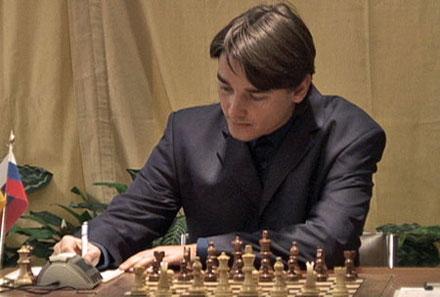
Typical Positions: Part 3
Today we will review typical positions where one side varied their move order and combined some well-known ideas to reach a new, completely fresh position. When you are familiar with plans and typical ideas, sometimes you don't need to exactly follow the most popular line - but instead rely on general positional knowledge to put your opponent in unfamiliar territory. The effect of novelty will add to their discomfort, especially players who study opening theory by rote memorization. We will look at few examples and eventually see how Morozevich used his knowledge to come up with a new idea in Slav.

This is a critical position in a popular Slav line. Black grabbed a pawn but got behind in development, so the next stage of the game will decide whether he manages to complete development and be up a pawn - or whether he gets checkmated. In this position most games continue in a same fashion: white takes the pawn on b5. The reason is that this move forces black to give up the dark-squared bishop for the knight, because otherwise he loses his only advantage: an extra pawn. Let us see how a few games developed from here...
What can we say about the game? The opening leads to very exciting positions. What of general ideas vs. specific lines? Obviously this line is very sharp, so not knowing specifics can lead to disaster right away. However, knowing typical plans is also important. Let us review the ideas that both sides implemented in this line. For white:
- white made black give up his dark-squared bishop for white knight;
- after what white developed the attack on the kingside using the knight as a leader;
- then the other pieces followed: Qh5 and pawn ramp h4 for the rook transfer into the 3rd-rank and for the attack;
For black we saw the following ideas:
- black has to hold on to the extra pawn on the queenside;
- there was nice Nd8 defensive maneuver to keep the f7-square overprotected;
- the key idea is the b4-break to have the c-pawn as a passed pawn.
Let us see another game in this line to make sure that these ideas are repeatable and reusable.
It seems that black had a defense, but it was a tough one to maintain. The Bb7-line seems to be very dangerous for black. It makes sense to look at some faster lines where the b4-break happens before Bb7. The game below happened a year ago in the Russian team championship.
One thing to notice is that in the above game, white castled instead of activating the rook via h3. And this is so because with the black knights in the center it was dangerous to keep the king in the center. Also, because black opened the position in the center, the white rooks can operate there more freely. The ideas of Ba3 to keep the king in the centre and the e6-break are actually from another masterpiece of Morozevich:
So Morozevich had some success in this variation, and one would think that he will stick to the move order he already used against Khairulin and Jakovenko. However, just a few days ago in the Russian Team Championship, he used most of the ideas from this variation to come up with a new move order. He did not insist on trading black's dark-squared bishop but instead started the kingside attack right away.
This game shows that some ideas can be recombined into different sequences. For example, Morozevich used h4-Rh3 idea but omitted the bishop exchange and the formation of black's pawn majority on the queenside. Although his attack was not as powerful, his aim probably was more about a long-term positional grip. Morozevich's idea also eliminated black's direct counterplay too. We will see whether his idea withstands time and practice, but it looks very interesting. If one knew the main ideas of this opening and forgot exact move order, one could still end up in the position after a:b5 or after h4 right away, as Morozevich did. Even in such a sharp line there is some room for improvisation!
More on this theme next week!

